

Pinterest. Oral Language Development. In order for students to engage in conversation we need to help them learn how to be effective listeners and speakers.

Students should know who their partner is, where to sit, and how to do a Turn and… read more Students should know who their partner is, where to sit, and how to do a Turn and Talk based on the teacher's expectations. It is important for students to understand how to take turns and have equal talking time. They need to lean forward, look each other in the eye and speak clearly. Anchor charts contain key elements of what is being taught, and should be hung up in the classroom for students to refer to. Read less. How to turn small talk into smart conversation. Imagine almost any situation where two or more people are gathered—a wedding reception, a job interview, two off-duty cops hanging out in a Jacuzzi.
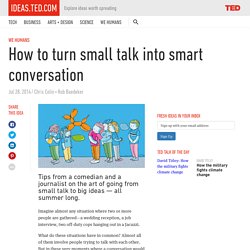
What do these situations have in common? Almost all of them involve people trying to talk with each other. But in these very moments where a conversation would enhance an encounter, we often fall short. We can’t think of a thing to say. Or worse, we do a passable job at talking. We stagger through our romantic, professional and social worlds with the goal merely of not crashing, never considering that we might soar.
We at What to Talk About headquarters set out to change this. Ask for stories, not answers. In Praise of Think-Pair-Share. Think-pair-share has gotten a bad rap.
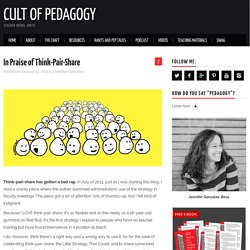
In July of 2013, just as I was starting this blog, I read a snarky piece where the author slammed administrators’ use of the strategy in faculty meetings. The piece got a lot of attention, lots of thumbs-up, but I felt kind of indignant. Lesson Idea: Think Pair Share. Think-Pair-Share. How to do a Think Pair Share - TeachLikeThis. Think-Pair-Share. Pinterest. Think-Pair-Share. Think-Pair-Share activities pose a question to students that they must consider alone and then discuss with a neighbor before settling on a final answer.
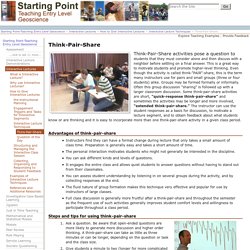
This is a great way to motivate students and promote higher-level thinking. Even though the activity is called think-"PAIR"-share, this is the term many instructors use for pairs and small groups (three or four students) alike. Groups may be formed formally or informally. Often this group discussion "sharing" is followed up with a larger classroom discussion. The Sheridan Center for Teaching and Learning. This type of activity first asks students to consider a question on their own, and then provides an opportunity for students to discuss it in pairs, and finally together with the whole class.
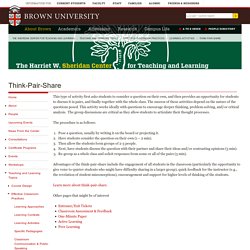
The success of these activities depend on the nature of the questions posed. This activity works ideally with questions to encourage deeper thinking, problem-solving, and/or critical analysis. The group discussions are critical as they allow students to articulate their thought processes. The procedure is as follows: Pose a question, usually by writing it on the board or projecting it. DoingCL - Think-Pair-Share. Think, Pair, Share Cooperative Learning Strategy: for Teachers. Page 1 of 2 What Is It?
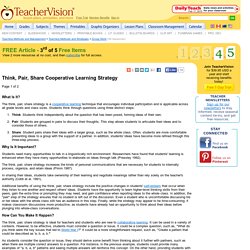
The think, pair, share strategy is a cooperative learning technique that encourages individual participation and is applicable across all grade levels and class sizes. Students think through questions using three distinct steps: Think: Students think independently about the question that has been posed, forming ideas of their own. Think-Pair-Share. Strategies for Reading ComprehensionThink-Pair-Share[Lyman, 1981] What Is Think-Pair-Share?
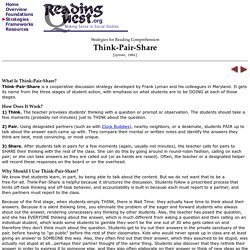
Think-Pair-Share is a cooperative discussion strategy developed by Frank Lyman and his colleagues in Maryland. It gets its name from the three stages of student action, with emphasis on what students are to be DOING at each of those stages. How Does It Work? 1) Think. 2) Pair. 3) Share. Visible Thinking. Purpose: What kind of thinking does this routine encourage?
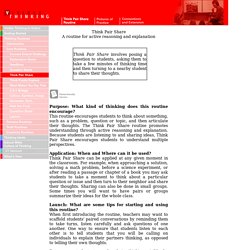
This routine encourages students to think about something, such as a problem, question or topic, and then articulate their thoughts. The Think Pair Share routine promotes understanding through active reasoning and explanation. Because students are listening to and sharing ideas, Think Pair Share encourages students to understand multiple perspectives. Application: When and Where can it be used?
Think-Pair-Share. HigherEd.Exchange. This week I have been discussing different strategies for working with groups of students where some students with more dominant personalities control the conversation.

There are two issues at play here: The quieter students often withdraw from the conversation and experience frustration at not being able to express their thoughts and opinions, andStudents who are mroe socially-inclined may resent being stopped to allow others to express their ideas, as they see their contributions as valuable. One technique that I have found effective in handling both aspects of this is to use Think, Pair, Share. Think. Students are encouraged to independently form their own opinions on a given topic. There has been a lot of research into the benefits of working with other people in learning contexts.
Think for a minuteWrite their thoughts for a minuteShare with a neighbor Think Pair Share can be applied at any given moment in the classroom. Some valuable resources that I have found on the topic include: